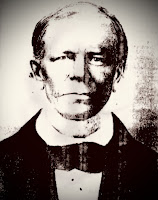I have a thick binder about the Thompson family, beginning with John Thompson of SC, b. 1751. Before that are rumors this family came from somewhere in the British Isles, or maybe even Germany, but after intensive research in Charleston, SC, I can say there were scores of John Thompsons and others who might be relatives. Thus, it is nearly impossible to sort them out without further evidence linking everyone. Perhaps DNA will eventually help.
I have not researched this line since 1999, and this is another family which has had extensive research done by others, so I do not worry about it. I tend to expend my efforts on family members about whom little is known, and, of course, now I write fiction about them.
Let me tell you what I do know. Credit for most of this goes to Betty Rolwing Darnell of Kentucky. Mom corresponded with various Thompson descendants from mid-Missouri before 1999, and they had information from Betty they passed along with their own information.
I have a real soft spot for the Thompsons, mainly because they were true Missouri pioneers. Their westward venture illustrates a typical migration of people who landed in Howard County, Missouri and surrounding “Little Dixie” counties, and John Thompson was one of the very first to come to Missouri Territory. His son, Nero Morgan Thompson, went on to Howard County.
John Thompson married Mary Jeffers (1756-abt. 1821) and their first known son, John, was born in an unknown location. Their second son, James, (1776-1852), however, was born in “Old 96” in a part now known as Union County, SC. “Old 96” is much larger than just Union County. It is the site of well-known Revolutionary War battles and is where other ancestors of our family fought and lived.
John’s son, our ancestor Nero Morgan Thompson (1794-1866), was born in SC according to the 1850 census; one could conclude it was in Old 96. John received a land warrant for “second-rate” land for which he was required to clear, fence, and tend corn for a year in order to buy in at sixty cents an acre. John bought 160 acres in Christian County, KY, and then more land to where he had more than 500 acres. He is found on the 1797 tax list in that county.
John Thompson sold his land in 1808, and sometime between 1800 and 1814, he settled near Egypt Mills, Cape Girardeau District, Missouri Territory. That time period is of great interest to me since researching and writing my “Louisa” series. I intend to write a saga of John’s son Nero Morgan Thompson’s family from the perspective of Elizabeth Williams, his wife. If I get a chance to expand that back to John’s settlement in the Cape Girardeau District, I will.
John Thompson and his first wife Mary Jeffers Thompson are buried in the Thompson cemetery on their farm near Egypt Mills.
This couple’s third son and seventh known child, was Nero Morgan Thompson, a pioneer of Howard County, Missouri where he settled c. 1816. He married Elizabeth Williams, and it is their son, John Thompson, who married his first cousin, fifteen-year-old Priscilla Williams, previously written about.
Elizabeth Williams Thompson, is a daughter of Colden Williams who is a sort of hero in Fayette, MO. If you want to get into the DAR or SAR, this is the line to follow because it is well-researched.
I digress.
I have a large binder full of information about Nero and his descendants and will defer further discussion of him until another time. Suffice it say, his story gives a very sentimental view (for those of us who love Howard County) of what it may have been like to settle there before Missouri became a state.


Comments
Post a Comment